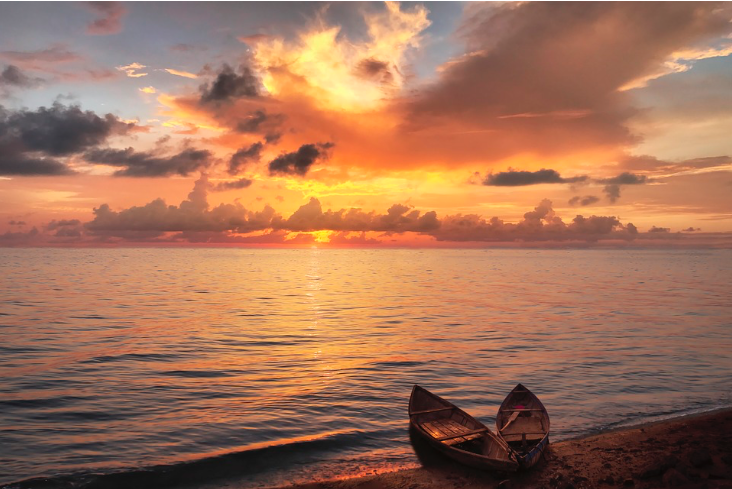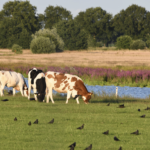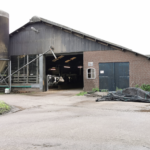(First published on May 2, 2019)
Jonathan Verschuuren
Throughout the world, lakes are facing deterioration due to intensive economic use. Climate change is exacerbating this situation. The only way forward is through implementing massive ecosystem restoration and connectivity policies, adjusted water management, and policies aimed at assisted colonization of endangered species. Current international and EU law do not explicitly require such policies to be developed and implemented, at least not in a legally binding way. In order to discover the legal prerequisites that facilitate the adoption and implementation of climate change adaptation measures for lakes, it would be good to have a look at some of the current best practices. One interesting example of such best practices is Lake IJssel (IJsselmeer) in the Netherlands, a protected lake under the Ramsar Convention and the EU’s Natura 2000 framework. In this blogpost, I will have a closer look at the adaptation policies in place for this lake with the aim to discover the legal conditions that have to be met for the adaptation policy to be effective. This case study is part of a bigger paper on this topic that was presented at an international conference at the University of Tehran on 14 April 2019, available here.
The creation of Lake IJssel
Lake IJssel (IJsselmeer) only became an inland fresh water lake in 1932, when the former Southern Sea (Zuiderzee) was closed off from the North Sea through the construction of a dam, called the Closure Dam (Afsluitdijk).[1]Originally, this was a sea arm, part of the estuary of the IJssel and Vecht rivers consisting mainly of marshes and shallow salt and brackish tidal waters. The sea arm was closed off from the North Sea in order to end regular floods that were occurring in the area and to create new agricultural lands to improve food security. After the construction of the dam, parts of the new lake area were reclaimed and converted into land. This land was not only used for agriculture, but also for new cities in order to reduce population pressures in the nearby Amsterdam urban area. The remaining water area became a series of interconnected inland lakes, all of which are now protected areas under both the Ramsar Convention and the EU Wild Birds and Habitats Directives.[2] Lake IJssel also became the Netherlands’ most important fresh water reservoir for drinking water and agricultural irrigation. It is the biggest fresh water area in northwestern Europe.
Lake IJssel’s poor conservation status exacerbated by climate change
Many of the species and habitat types for which this lake has been designated under the EU Wild Birds and Habitats Directives are not in a favourable conservation status, as required by these important EU biodiversity instruments.[3]There are several reasons for this. First, and foremost, the transition from this area from a coastal marshland area into an artificial fresh water lake had severe consequences for the naturally occurring ecosystems. A new natural equilibrium has not been reached yet. The water of the lake has excessive quantities of sediments and is increasingly low on nutrients and marshes are disappearing. Over-fishing and increasing pressure by recreation, combined with active human manipulation of water levels to allow for intensive farming and urbanization have turned the lake basically into a big tub with muddy, empty water. The number of fish and other water organisms have declined tremendously, as has the number of birds. Climate change is exacerbating this already poor situation through:[4]increasing water temperatures (leading to reduced oxygen levels and increased harmful algae blooms), increasing intrusion of alien invasive species (such as the quagga mussel, which affects natural algae and native mussel populations, as well as power and water treatment infrastructure), increasing peaks both in low water levels caused by droughts and high water levels caused by increased precipitation and increased river water run-off, bigger impact of several chemicals, such as phosphates from agricultural run-off in case of high water situations, and chloride from upstream salt mines in France in case of low water levels in summer, bigger impacts from recreation due to longer recreation seasons, increased flood risks due to accelerated sea level rise, which will make it increasingly difficult to flow off river water into the (higher) North Sea.
Legal requirement to restore the degraded Lake IJssel
Lake IJssel was designated as a wetland of international importance under the Ramsar Convention in 2002 and as protected area under the EU Wild Birds and Habitats Directives’ Natura 2000 network in 2010. The EU Directives contain much stricter legal obligations than the Ramsar Convention and have much more legal force through the fact that EU legislation is directly binding under domestic law of the EU Member States and through an enforcement mechanism through the Court of Justice of the EU. As a consequence, the Ramsar Convention has lost much of its relevance for those areas that have also been designated under the EU’s Natura 2000 network (which is the case for all Ramsar sites in the Netherlands).[5]
For areas designated under the EU Wild Birds and Habitats Directives, conservation goals need to be set, aimed at the specific habitat types and species for which these areas have been designated. As most of the habitat types and species for which the Lake IJssel has been designated under the Natura 2000 network are not in a favourable conservation status, many conservation goals aim at increased populations or at increased acreage for certain habitat types. The latter can only be achieved through restoration, hence restoration is a legal requirement for Lake IJssel. In order to comply with this requirement, the management plans for the lake have adopted a wide range of restoration actions, some of which focus on the climate change related measures discussed in this paper (ecosystem restoration and connectivity, adjusted management, assisted colonization). These will be discussed below. It should be noted that the management plans for Lake IJssel do not just focus on nature conservation, but on all relevant environmental issues. A range of legal frameworks apply to the lake, partly stemming from the EU, such as on water quality and flood management, partly from domestic level, such as on polluted water soils and spatial planning. Furthermore, all of these plans are part of a broader development policy for the Lake IJssel area, called ‘Agenda Lake IJssel area 2050’, covering not just nature conservation, but also water safety, (drinking) water supply, water quality, fisheries, sustainable energy, infrastructure and transport, sand extraction, landscape conservation, culture, recreation and tourism.[6]
Restoration plans for Lake IJssel
The first phase of the plans, which runs from 2017 until 2023, primarily aims at stopping the decline in quality and quantity of habitat types and species. To achieve that, the current plan has five main goals: improvement of marshes on the edges of the lake for breeding reed birds, creation of new sandy breeding areas for water birds that breed on sandy beaches, improvement of availability of food for birds, improvement and enlargement of certain habitat types, and more space and tranquility for birds.[7]
Most, if not all of these goals align with the climate change related adaptation measures that are generally considered important, such as restoration and connectivity, and adjusted management. It is remarkable, though, that climate change is not mentioned a lot in the various documents detailing the restoration requirements for Lake IJssel. I assume that this is because of the already poor conservation status that requires urgent action even without climate change.
The following table lists some of the restoration measures that contribute to climate change adaptation for the lake (despite the fact that they were not specifically proposed with that focus).[8]
| Ecosystem restoration and connectivity | |
| measure | aim |
| Replacing artificial, fixed banks by more natural banks and bordersCreating sandy islands in the main water body of the lakeConstructing a fish migration riverOpening up old creeks and streams | Gradual transition from water to landIncrease breeding space for birds & help sediment settle down thus improving water quality for (shell)fishEnable migratory fish to bypass artificial damsRestore natural connection between land and water |
| Adjusted management | |
| measure | aim |
| Targeted reed management (keep young reed plants in some areas, and perennial reed in others)Introducing permits for commercial fishing with conditionsBanning certain recreational activities (boasting, kite surfing) in some areasConcluding voluntary agreements with recreational sectorAdjust water level management to more natural levels is preferred; however, this measure is postponed to later, to be aligned with water management plans under climate change | Enable expansion of various species of reed birds and reed mammalsAvoid water birds getting caught in nets and other fishing gearReduce disturbance of protected birdsInform and educate the public so as to achieve less impact on breeding birdsEstablish natural water levels, plan for climate change related variations of water levels |
Assisted colonization is not specifically addressed in the management plans. Yet, to some extend, this measure is relevant, although not connected to climate change. In the 1980s the Eurasian otter became extinct in the Netherlands, mostly due to water pollution in the previous decades. The species, however, was reintroduced and now is back in a viable population in the Lake IJssel area. Furthermore, some of the restoration measures do aim to facilitate the natural relocation of species that were not present in the area before. The latter is particularly true for the white tailed eagle that has colonized the area and has been breeding here since 2006. The artificial fish migration river mentioned above helps salmon and other migratory fish to recolonize the lake and the rivers feeding the river. The assisted relocation of soil disturbing fish species from another part of the area to the lake is considered with the aim to improve the quality of the water soil.
Enabling factors for the restoration plans for Lake IJssel
In this section, I will deal with some important enabling factors that determine the success of the plans sketched above: the available financial budget, the role of the various authorities and other stakeholders involved, and the the role of the general public.
Financial budget: The measures discussed above, go at a cost. It is, therefore, important to adopt a multi annual budget. Otherwise, the risk exists that the plans are not executed, or that implementation stops mid-way. In the restoration plans for the Lake IJssel, implementation costs for each of the measures proposed has been included. The estimated budget consists of two elements: costs for construction or establishment of the restoration measures (once off costs), and costs for the first ten years of maintenance of the restoration measures. The total amount of once off implementation costs is between 630 and 1,060 million euro plus between 41 and 89 million euro for maintenance costs for the first ten years.[9]
The role of the various authorities and other stakeholders involved: The governance structure of Netherlands can be characterized as a decentralized unitary state. This means that central government involves the provinces, municipalities and water districts in the formulation and execution of its policies.[10] Hence, consensus building is considered to be of vital importance and the Netherlands has a long tradition of always looking for consensus among all those involved. This tradition dates back to early coastal defense and land reclamation activities around 1200, so even predating the establishment of the Dutch State: such activities were only possible with the collaboration of everyone, and, thus through balancing everyone’s interests. This has led to the enactment of laws that have a subtle, and somewhat complex, system of joint decision-making on such topics as water management, nature conservation, and spatial planning. As a consequence, many government bodies are involved in the implementation of the restoration plans for Lake IJssel, as follows. Central government is responsible for coastal and flood defenses that are of national importance (i.e., all coastal defense systems and flood defense systems of the main rivers), as well as for complying with EU-law requirements (vis-à-vis the European Commission). Provincial governments are responsible for nature conservation, and for coordinating water management and spatial planning. Water district boards are responsible for water management (in a broad sense, including water related nature conservation), and municipal governments are responsible for local spatial planning. As the Lake IJssel area is located within four provinces, has 32 municipalities and six water districts, and since five central government ministries are involved in the broader development plans of the area, intensive collaboration among all of these actors is in order. Such collaboration is coordinated by the Minister of Infrastructure and Water. Also involved in this process are non-governmental stakeholders, such as (agri-) businesses and environmental NGOs. Environmental NGOs actually play an important role, as several NGOs own property within the protected areas.
The role of the general public: Local residents, businesses and NGOs are also involved through the regular administrative procedures that need to be followed with all government decision-making (at all levels) and that require effective public participation and access to justice. Hence, there are public hearings and other forms of public participation, and all interested parties have the right to go to court. Thanks to the intensive collaborative decision-making processes aimed at reaching consensus (as sketched above), there, generally, is broad support for the plans once they are adopted. Nevertheless, every administrative decision that is taken to implement the restoration plans, can end up in court. Often, court cases focus on the question whether a certain decision is in compliance with EU law, for example with the EU Wild Birds and Habitats Directives.
Assessment of the Lake IJssel restoration plans
The restoration measures included in the first management plan for Lake IJssel are important first steps to bring the ecological quality of the lake back to an acceptable level. Species and habitat types that are in a favourable conservation status are much more resilient to climate change than species and habitat types that are in a poor condition. The measures aimed at increased connectivity, such as the creation of a fish migration river and of new islands in the lake for the sake of nature are spectacular and have fascinating results even within the first few years after these measures were taken. It is also clear, however, that much more is needed to make the area completely resilient to climate change. Especially those measures aimed at restricting harmful human activities still need to be taken. So far, only some preliminary measures aimed at regulating commercial fishing and recreation were adopted. More restrictions, especially for commercial fishing are considered necessary, which requires redistribution of existing fish permits and closing of certain parts of the lake for fishing. More drastic limitations on shipping and agriculture will follow from restoring natural water levels. Creating more connections with the sea, between the various parts of the lake area, and with the rivers feeding the lake, would also greatly enhance the resilience of the area, but is considered to be risky from a water safety perspective. The current approach of setting small steps towards a gradual more natural ecosystem seems effective for now, but we have to wait and see whether this approach will still work when tough decisions need to be taken that are costly and will have clear negative economic side effects.
[1] F. Palmboom, ‘Introduction. Lake IJssel – The IJsselmeer’ in: A.L. Nillesen et al. (eds.), Delta Interventions: Design and Engineering in Urban Water Landscapes (Delft University Publishers 2016) 52-53.
[2] Eemmeer, Gooimeer, IJsselmeer, Ketelmeer, Vossemeer, Markermeer, IJmeer, Veluwerandmeren and Zwarte Meer. Officially, these are all considered separate lakes, with the IJsselmeer being the largest. In this blogpost however, I treat them together under the overall name of Lake IJssel as they are largely (although not entirely) interconnected and all protected under the same legal regimes.
[3] See for example this document (in Dutch) that discusses the conservation status of a very long list of habitat types and species that require protection under EU law in part of the Lake IJssel area,
[4] R. Loeve et al., Klimaatverandering en waterkwaliteit (Future Water 2006), available online; Deltares, Mogelijke gevolgen van versnelde zeespiegelstijging voor het Deltaprogramma. Een verkenning (Deltares 2018), available online. See also the government website on climate change impacts for the Lake IJssel area.
[5] J. Verschuuren, ‘The Case of Transboundary Wetlands Under the Ramsar Convention: Keep the Lawyers Out!’ (2007/2008) 19(1) Colorado Journal of International Environmental Law and Policy 49-127.
[6] See the special website on this policy.
[7] Ministry of Infrastructure and Environment, Natura 2000 Beheersplan IJsselmeergebied 2017-2023. Publiekssamenvatting (Rijkswaterstaat 2017) 7-8.
[8] Taken from a range of documents on the management of the Natura 2000 sites of Lake IJssel,all of which are available here, and here.
[9] A. Remmelzwaal et al., Preverkenning IJsselmeergebied (Ministry of Infrastructure and water 2017).
[10] See extensively, Wil Zonneveld, Governing a Complex Delta, in Han Meyer, Steffen Nijhuis, Inge Bobbink (eds.), Delta Urbanism: The Netherlands (Routledge 2017), chapter 5.



